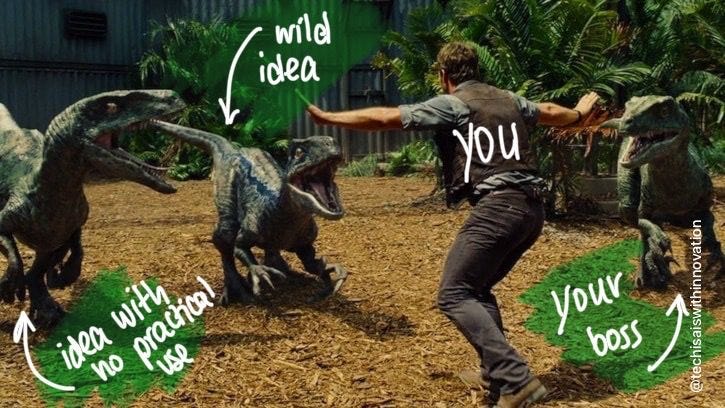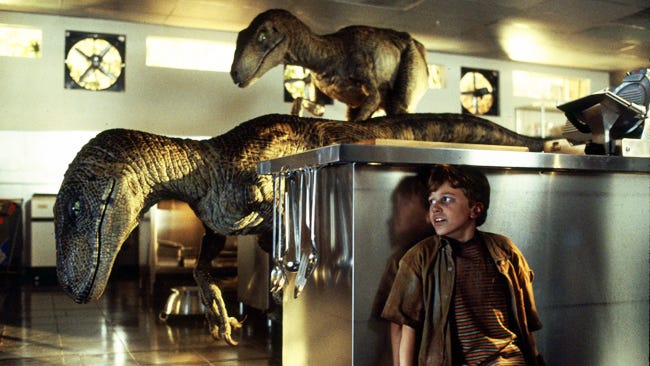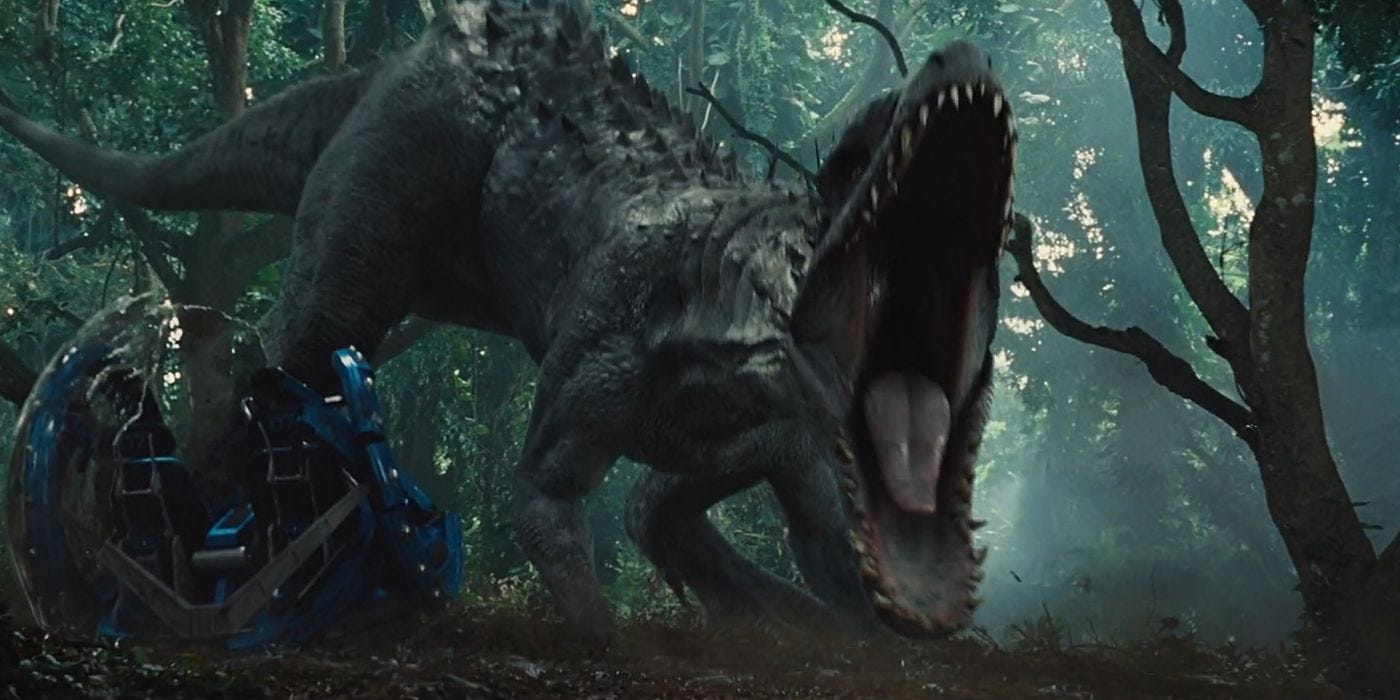When Innovator's Wild Ideas Get a Little Bit... Side-Tracked by Dinosaurs
How Spielberg's dinosaur movie became a playbook (and a cautionary tale) for balancing ambition with reality

Today, let’s dive into an iconic tale of bold innovation and... well, some slightly chaotic outcomes.

We’re talking about Jurassic Park, Spielberg's legendary film where an eccentric millionaire brings dinosaurs back to life, and everything goes perfectly smoothly…
… just kidding! Of course that wouldn’t be an action movie, so that didn’t happen.
Jurassic Park is a 30-year-old classic movie, but let’s keep it spoiler-free (for the 10 people who probably haven’t heard about it). It’s an action-filled movie, full of moments where you think they’ll die on the claws or mouth of these big dinosaurs.
I will use two examples from the Jurassic franchise movies: Jurassic Park (1933) and Jurassic World (2015).
First, let’s set the tone:
Have you ever had these wild ideas, maybe even during a brainstorming, over lunch or while commuting to the office? Something you think that might work for the problem you’re trying to solve?
You might have found yourself a little bit like this:

All rights of the original image go to the Universal Pictures. Notes and ideas drawn by me for this article.
When is it a healthy wild idea, and when might you lose complete control over it, and it might come to bite you?
That’s today’s mission: the Jurassic Park franchise is built on the premise of the danger of wild ideas, and why today we’re using this movie as an example about balancing ambition with a bit of cautious reflection when you have wild ideas in front of you.
Wild Ideas: the thing that drives the Innovation Hollywood-represented millionaires love
Think of the depiction of millionaires in movies: from Bruce Wayne becoming Batman, Tony Stark becoming Iron Man, it’s quite common that they always have wild ideas. We also have it in Jurassic Park: Imagine something wild, like creating a dinosaur park.
The idea itself could be interesting, something truly groundbreaking. In the movie, John Hammond, an eccentric dreamer and millionaire, embodied the spark of innovation: he wanted to amaze the world. And he did, kind of.
Jurassic Park is a theme park of cloned dinosaurs on Isla Nublar, off the coast of Costa Rica. After a handler is killed by a Velociraptor, the park's investors demand a safety inspection. So Hammond invites scientists, including paleontologist Alan Grant (played by Sam Neill), paleobotanist Ellie Sattler (played by Laura Dern), and chaotician Ian Malcolm (played by Jeff Goldblum, his job being focused on chaos theory and the unpredictability of complex systems).
Upon arrival, the group is quite surprised (in a positive way) at live dinosaurs but soon starts questioning the park's safety and ethics. Hammond’s grandchildren join the tour, which starts getting worse and increasingly dangerous after a tropical storm hits.
Meanwhile, a programmer Dennis Nedry, approached by competitors, deactivates security to steal dinosaur embryos, leading to widespread chaos (let’s say this Nedry could be your ego trying to make this idea work even when you’re being told it shouldn’t be done).
The Tyrannosaurus rex escapes and starts attacking the group. At the same time, Velociraptors also break free, leading to intense moments of survival.
The Kitchen Scene - Fear and Alignment

Remember that scene with the velociraptors in the kitchen? It’s tense, chaotic, and a perfect metaphor for what happens when our ideas get out of control. The fear that Alan and the kids face can be similar to the fear we feel when our projects grow beyond our control.
It’s a reminder: pushing ahead solo without asking for feedback or making sure our innovations fit the bigger picture can lead us straight into raptor territory.
Innovation is exciting, but we need to make sure our wild ideas align with our broader goals: whether that's the company mission, values, or simply making sure we’re not headed for chaos. Otherwise, you might end up cornered by something you can no longer manage.
Remember the Power Map? This is one of the ways to use it in this case.
Iteration and Improvement
The funny thing with each movie of the Jurassic Park franchise is that it seems they forget their major lessons, hence another movie has a 1h20 worth of action-based plot.
But what we can all take from here is that iterating and making adjustments are what move an idea from a chaotic start to something that might actually work. Hammond’s dream, after all, wasn’t wrong: it needed more security before monetizing it.
If you consider Jurassic World, years later in the same theme park created by Hammond, they have implemented Hammond’s vision. They made a theme park, tourists are visiting, enjoying it, and it seems safe… until they want bigger and better attractions, which leads them to create a genetically-engineered dinosaur, the Indominus Rex.
What happens is that they forgot that the company vision probably wasn’t to transgenically create new, stronger, worse dinosaurs. One so unpredictable, that it was smart, starting to camouflage itself and using the new behavioral intelligence to trick humans.
Predictably, things go off the rails when this new creation, designed to be bigger and scarier than anything before, escapes and puts everyone at risk. Despite their high-tech advancements, they fell into the same trap: overestimating their control over the wild. Just because we can push innovation doesn’t mean we always should.
Unlike the initial Jurassic Park, the danger in Jurassic World isn’t just from nature's unpredictability; it’s from actively creating something that surpasses natural limits without a proper plan for handling it.
By ignoring the experts that were warning against this transgenic creation, in this case, Owen Grady (played by Chris Pratt), they end up having several people killed.
If you ask me, the idea of weaponizing a man-created dinosaur had everything to go wrong…

The Indominus Rex | Jurassic World (2015) - All rights go to the The Universal Pictures
Balance Over Oversight
In the movie, there was a lot of emphasis on control, which ultimately failed. Instead of focusing on tight oversight, imagine a system of balanced checkpoints: places to align with the overall company goals and gain fresh perspectives.
These checkpoints won’t or shouldn’t killing momentum, but rather make sure innovation succeed without putting people, jobs, or the company at risk.
Your ideas deserve the chance to grow, but that growth is best supported when you pause every now and then to make sure everything is still on track.
Last thing: it’s not just the movie itself that can teach us a thing or two about innovation…
Spielberg’s Innovative Movie-Making
Spielberg’s approach to innovation on the set of Jurassic Park is a great example of what we’re talking about today.
Growing up, I loved Spielberg’s movies. Maybe it was because they kept playing on major TV channels during weekends, and I’d just watch whatever was on. From E.T. to Indiana Jones, Spielberg made stories that were both imaginative and relatable. And when Jurassic Park came out, it was something entirely different, it changed how we look at movies, especially CGI.

Article from Adam Bargteil, “‘Jurassic Park’ made a dinosaur-sized leap forward in computer-generated animation on screen, 25 years ago” The Conversation
When it first premiered, in 1993, Jurassic Park was already a marvel of movie-making. Spielberg managed to bring dinosaurs to life in a way that had never been done before. The result was astonishingly realistic dinosaurs that captivated audiences everywhere. It was this blend of old-school effects and new technology that made the movie so groundbreaking. The T-Rex wasn’t just a computer simulation, it was a massive animatronic beast that could terrify the actors just as much as the audience.
Today, we take for granted the ability to create massive, realistic environments and creatures with CGI, but back then, it was nothing short of revolutionary, which even industry colleagues highly praised:
“Yet Jurassic Park stands out historically because it was the first time computer-generated graphics, and even characters, shared the screen with human actors, drawing the audience into the illusion that the dinosaurs’ world was real. Even back then, upon seeing the initial digital test shots, George Lucas was stunned: He’s often quoted as saying “it was like one of those moments in history, like the invention of the light bulb or the first telephone call … A major gap had been crossed and things were never going to be the same.”
He wasn’t afraid of using new technology, but he balanced it with tried-and-true methods. He brought in experts from multiple fields: puppeteers, CGI wizards, and robotics engineers, and encouraged them to collaborate to bring his vision to life. He’s that type of perfectionists, as is George Lucas (Star Wars), that would rather wait some time to get the technology they need for the vision they want to achieve, but also going after it with new ways when they think they can make it. In this case, they used the best available tools to make the audience believe in the unbelievable.
Don’t take me for it: listen more about the ground-breaking film-making innovations, explained by Spielberg himself!
Note: If you’re watching this with headphones, you might want to tone the volume down before you proceed
Thirty years later, we still look at Jurassic Park not just for the dinosaurs but for the audacity and innovation that made it possible. It’s a reminder that with the right balance of vision, tools, and teamwork, truly incredible things can happen.
Takeaway for the Week
As you head into this week, let your wild ideas flow. 80% of the time, I’d say go for it (don’t quote me here in case it goes south, I’m ball parking it).
But while you’re out there and letting your wild ideas flow, please do ask yourself:
Does this wild idea align with the broader mission or vision of the company/ the department / your team?
Have you sought feedback from trusted colleagues, or the end-user of this wild idea/ concept you want to implement, to ensure you're not missing crucial perspectives? Are you hearing only yourself?
What could potentially go wrong, and have you thought of how you can safely test this? For instance: if you’re thinking of a new input form to collect data, don’t delete the old one before you trust the new one!
Is there a point where you should reassess and decide whether to continue pursuing this idea, or is it just running wild?
Just remember to:
Keep an eye on alignment:
> whether it’s the company’s north star,
> the value proposition,
> or simply a gut check from a trusted colleague.
When trying out wild ideas, it's also important to define:
> when you should stop attempting it
> how to test and fail trying out this wild idea in a secure way that doesn't kill your company
Bold ideas are what push us forward, but the right checks and balances ensure they don’t grow claws and start chasing you around the office.And remember, nature finds a way, so make sure your innovations are finding the right way and don’t come biting you when you failed to put up the right walls secured.
What do you think?
If you try to think about Jurassic Park now, what comes to your head?
Hey! This is a content I've created for my newsletter and Substack, Innovation from Within. Don't worry, I won't spam you! But do check out my profile if this resonated with you, you'll find more posts over there.
If you made it this far, I just want to let you know I'm writing Peerlist-exclusive content, and How to pitch your ideas at work is already out!

How to pitch your ideas at work
This week I'll post the second article about Pitching, with more actionable tips! Stay tuned!
Join Francisca on Peerlist!
Join amazing folks like Francisca and thousands of other people in tech.
Create ProfileJoin with Francisca’s personal invite link.
0
2
0